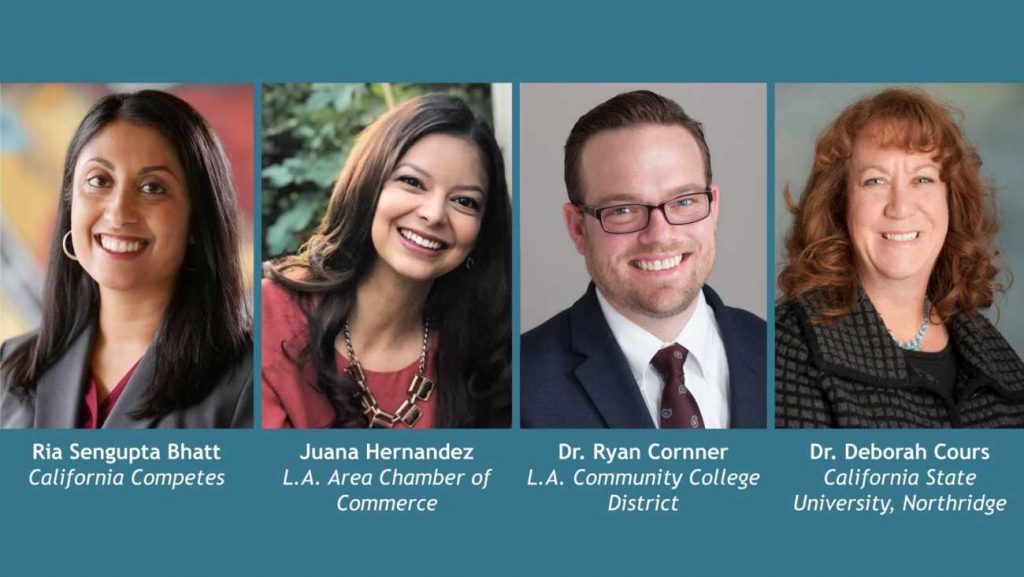Higher Ed Chat: The L.A. Compact and CSUN Connections

In our Back to College series, we explore California’s four million adults aged 25-64 who left college before completing—a population with substantial higher education needs that are not currently being met. These adults face significant barriers to re-enrollment and consequently have difficulty advancing in the workplace, which can then limit opportunities for upward socioeconomic mobility. As policymakers consider changes at the state level to help more students achieve postsecondary success, regional cross-sector collaborations offer important takeaways.
California Competes Interim Executive Director Ria Sengupta Bhatt recently chatted with representatives from the Los Angeles Area Chamber of Commerce, California State University, Northridge (CSUN), and the Los Angeles Community College District about CSUN Connections, a reverse transfer initiative to support adults with some college but no degree in the Los Angeles area. Joining the conversation were:
- Juana Hernandez, Senior Manager of Postsecondary Initiatives at the Los Angeles Area Chamber of Commerce
- Dr. Ryan Cornner, Vice Chancellor, Education Programs & Institutional Effectiveness at the Los Angeles Community College District
- Dr. Deborah Cours, Interim Assistant Vice President of Academic Undergraduate Programs at California State University, Northridge
Read what they had to say about this important work below.
Ria Sengupta Bhatt: Hello everyone, thank you for joining me today. I am excited to learn about how your work supports adults with some college but no degree. First, could you explain the concept of reverse transfer and how you decided to launch CSUN Connections?
Juana Hernandez: CSUN Connections was born out of the L.A. Compact Student Success Workgroup, a body that offers senior academic administrators from our local community colleges, four-year institutions, and the L.A. Unified School District opportunities to identify common challenges and develop collaborative solutions. The group identified a need to increase coordination in our region so that students can experience transfer pathways in a more seamless way. We had a feeling we were losing too many students on their way to a bachelor’s degree. CSUN looked at their own data and saw many students were transferring in without an associate degree and were then, several years later, leaving CSUN without a B.A. in hand. CSUN realized how much of an impact they could have by partnering with the community college district to ensure that these students who had been going to school for many years—accumulating a lot of credits along the way—actually have a degree to show for their efforts.
Dr. Deborah Cours: Traditional transfer is where a student starts at a community college and brings credits to a four-year institution. Reverse transfer is the idea of identifying students who can apply lower division credits from a four-year institution toward completion of an associate degree at a community college partner, “reverse transferring” those credits.
Dr. Ryan Cornner: For CSUN Connections, we’re looking for students who had already earned either all or a great proportion of credits required for an associate degree but have not been awarded that credential. We know there is a significant difference in a student’s earning potential if they have an associate degree, versus having some college credits but no credential.
It’s important for the business community to understand how their needs can be served by candidates with associate degrees and why programs like CSUN Connections are so critical to helping employers find skilled talent.
Juana Hernandez
Ria Sengupta Bhatt: Where are you along the timeline of this initiative?
Juana Hernandez: We first spent time reviewing the data to understand the student population we’re trying to engage and imagine the pathways they could take to an associate degree. CSUN Connections has two pathways—“Claim What You’ve Earned” for CSUN transfer students who left CSUN before finishing, and “Re-Route to Success” for CSUN first-time freshmen who’ve been academically disqualified after their first year of college. Next, we outlined the various steps in terms of communication, student outreach, data identification and exchange, and degree audits. CSUN initiated communications campaigns at the end of the 2018 fall semester and reached out to the two student populations we’re targeting. Now the community colleges have actually started to award degrees, which is really exciting.
Ria Sengupta Bhatt: What can a program like reverse transfer do for the regional workforce?
Juana Hernandez: Like California Competes, the L.A. Area Chamber of Commerce is very aware that we need to take action now to address our current and future workforce skills gap. There are many employers that have openings that don’t require a bachelor’s degree, but I think oftentimes in hiring practices, the B.A. becomes the default. It’s important for the business community to understand how their needs can be served by candidates with associate degrees and why programs like CSUN Connections are so critical to helping employers find skilled talent. We really believe the business community can and should partner with higher education so that we can help more Angelenos attain a postsecondary education and contribute to our regional economy.

Ria Sengupta Bhatt: What challenges or lessons would you share with other regions or institutions that may be interested in launching a similar reverse transfer initiative?
Dr. Deborah Cours: It’s been harder than expected to get the message to these students that we have this pathway available for them to get their associate degree. We’ve tried a text campaign and an email campaign. We have a website, and we’ve sent them mail. We’re using sophisticated analytics to test message success so that we can adjust our efforts and reach more students. Some of our community college partners have even reached out by phone. We’re trying to find creative ways to get the message right.
Dr. Ryan Cornner: In addition to thinking about how to effectively communicate the message to students, I would suggest to regions or institutions considering a similar initiative that they should get all of the decision-makers in the room to make sure that all of the issues are straightened out right from the beginning. There’s a tendency to identify all of the challenges or barriers to implementing a program like this because it’s not the normal practice. I think we have been successful by getting the right people in the room so that we could focus on how to make this work, rather than focusing on the reasons why it might not work.
Ria Sengupta Bhatt: Where would you like this program to be five years from now?
Dr. Ryan Cornner: I’d like to see two things from this program five years from now. First is the ability for all the community colleges and university partners to be using this model across the entire state. I’d also like to see a robust conversation about the policies related to the transfer of credit back and forth between our California Community Colleges and California State University system. Up until this point, the entire concept in our state educational code has been one of credits moving forward from the community college to the university. I think that there’s a need at the state level to recognize that the state has already invested in all students, regardless of the system in which they enter or exit higher education. Our higher education segments, including the community colleges and the CSU, need to be much more integrated so that students can attain the credentials that they’ve already earned.
Juana Hernandez: We’re in an exciting time with the new gubernatorial administration, and I think there is real appetite and interest in Sacramento to think through ways that our state legislature, our executive branch, and our systems offices can enable pilot projects such as these to not just take root but to also grow and scale. We are being thoughtful, and I know California Competes is also being thoughtful about what could benefit the state–whether that is a longitudinal data system that helps us better understand student pathways or a higher education coordinating body that helps us work as one higher education system to set attainment goals that are aligned with regional workforce needs.
I think we have been successful by getting the right people in the room so that we could focus on how to make this work, rather than focusing on the reasons why it might not work.
Dr. Ryan Cornner
Ria Sengupta Bhatt: Reverse transfer, by definition, requires having multiple institutions involved, and that can be tricky. How do you think about coordinating institutions and how are you doing that successfully?
Dr. Deborah Cours: What’s really impressed me is that every single person here at CSUN and with our partner campuses is so convinced about the value of this program. This is such a great project, and we know it’s valuable for our students. Even within a large institution like this, people on the ground really care about students—we’re student first—that enthusiasm carries through. And thanks to the L.A. Compact that organizes us, we have this sense of community with our partners, so it’s really seen as a team effort. Regardless of who gets to award that degree, it’s a win for the student and that means a win for all of us.
Ria Sengupta Bhatt: California Competes’ research shows that older students, returning students, and student parents are increasingly the norm in our state. Why do you think higher education leaders should increase their focus on adult students?
Dr. Deborah Cours: One of my real efforts over the past two years has been to focus people in all areas of campus to think about how we support students who don’t have the privilege to attend classes and activities during traditional times. If club meetings are always at noon, for example, what does that say about the availability of those opportunities to many of our students? A large percentage of our students are working to support a family and to support themselves in this very high cost of living city. When employers rely on low paid or unpaid interns, they privilege the population of students who can afford to take those opportunities. We’re exploring initiatives that let us provide funding to students so they can take advantage of an internship that might pay less than their job would pay. We also need to talk to employers about how important it is to pay for your interns so that they can draw from our diverse student body that brings that wealth of experience. I think we have to engage the whole higher education and workforce ecosystem in this conversation so that all students have an equal fair chance to have those opportunities.
Regardless of who gets to award that degree, it’s a win for the student and that means a win for all of us.
Dr. Deborah Cours
Ria Sengupta Bhatt: That’s a great point. What other issues are important to consider from a policy perspective?
Dr. Ryan Cornner: There’s a nationwide push to end the stigma of community colleges, and that’s something we faced with this project. The students CSUN Connections focuses on were admitted to the university either as freshmen or as transfer students, and we had to carefully craft our message in a way that didn’t make it seem like we’re encouraging them to “step backward” to go the community college system. I think that’s a challenge that we’re going to have to address at a cultural level across our state and within our businesses and other environments where people have an understanding of the value of the two-year degree.
Outcomes data are not yet available for CSUN Connections, but program partners expect to continue to grow the initiative over the coming year and plan to make the results very visible.
Learn more about CSUN Connections here.